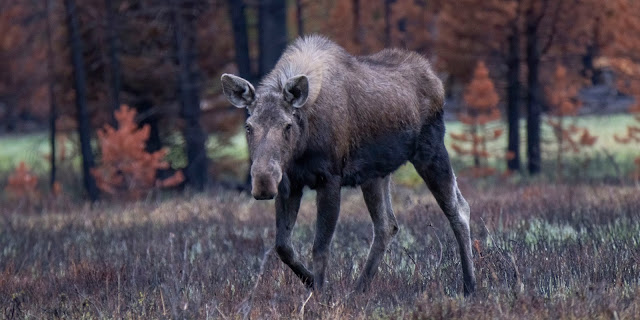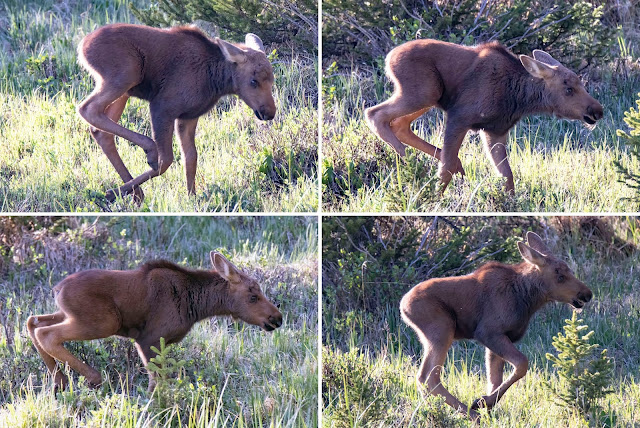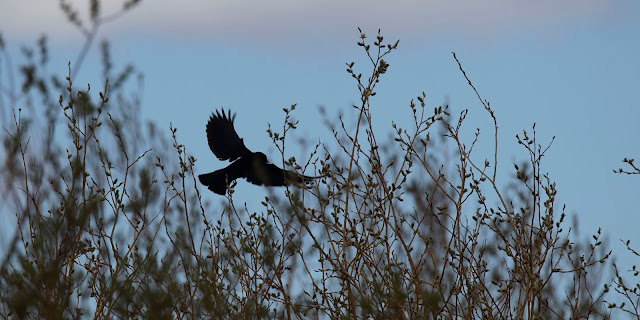 |
| Moosecapade is about scenery and wildlife |
We call it Moosecapade.
 |
| An annual trip to see Shiras Moose in Rocky Mountain National Park |
During the late spring, Moose cows and their calves come into the grassy meadows to graze and it is not unusual to see up to 50 individual Moose in one weekend.
Yes, there are Moose in other places, increasingly on the East Side of RMNP and in other places such as Brainard Lake, Maroon Bells, Cameron Pass and State Forest State Park. There was one in Colorado Springs a few days ago, but that is rare.
But, no area is as reliable and prolific as the West Side of RMNP in the late spring/early summer.
And, yes, we go to the Park other times to view Moose. We usually have a modified Moosecapade in the fall to see big boys with antlers.
 |
| We look for bulls in the fall when antlers are bigger than this |
Planning takes several things into consideration:
Where can we stay: camp or cabin?
Is Trail Ridge Road Open? It usually opens around Memorial Day, but spring snows can either keep it closed longer or cause it to re-close temporarily.
 |
| That snow fell while we were there in June, temporarily closing Trail Ridge Road |
First Time Back
This year, spring Moosecapade was a bigger deal because it would be the first time we had been back to the West Side after last year’s East Troublesome Fire.
This year, spring Moosecapade was a bigger deal because it would be the first time we had been back to the West Side after last year’s East Troublesome Fire.
And, it was devastating ...
This explanation comes from Colorado Encyclopedia (edited for length):
One of the most destructive wildfires in Colorado history, the East Troublesome Fire began on October 14, 2020, in the central Rockies east of Troublesome Creek in Grand County. A week later, high winds whipped the fire into a 100,000-acre inferno racing northeast through Grand Lake and into RMNP.
By the time snows and colder temperatures halted the fire in late October, it had killed two people, destroyed more than 400 houses and structures, and burned 193,812 acres, making it the second-largest fire in state history.
 |
| Burn area |
The fire is believed to be human-caused but remains under investigation. Parts of RMNP remained closed through the week of Thanksgiving 2020.
The East Troublesome Fire was the third record-breaking fire of 2020, with all three blazes surpassing 130,000 acres.
Colorado's 2020 fire season got off to a late start, but fires worsened as a hot, dry summer turned to a dry, warm fall. Fires that had burned for weeks were fully contained by September. In October, the Cameron Peak Fire west of Fort Collins became the largest blaze in state history and Colorado's first wildfire to surpass 200,000 acres.
In the fall the entire state was still in a moderate drought, but the drought in the central Rockies became extreme because of higher-than-normal daytime temperatures, strong winds and low humidity.
 |
| Photo: OutThereColorado |
High winds on the evening of October 21 sent the 25,000-acre East Troublesome Fire racing northeast at a rate of 6,000 acres per hour. By dawn, it had grown to 125,000 acres, burning through parts of Grand Lake and into RMNP, leaving dozens of charred houses and other buildings in its wake.
 |
| The damage is significant; the fence is new |
 |
| The Granby evacuation; Photo: Colorado Sun |
On the afternoon of October 22, the fire crossed the Continental Divide, burning another 50,000 acres and prompting mandatory evacuation for the entire town of Estes Park, displacing some 6,500 people.
On October 24, authorities recovered the bodies of Lyle and Marilyn Hileman, a couple in their 80s who had stayed in their home near Grand Lake.
Containment slowly progressed as snow started falling in the burned area in November.
By November 19, the East Troublesome Fire was 72 percent contained.
Although it was still not extinguished by Thanksgiving, the fire no longer threatened communities.
Before the 21st Century, Colorado had not seen a fire grow beyond 100,000 acres. Since 2000, however, there have been six – and three of them occurred in 2020.
Accumulation of greenhouse gases in the atmosphere from human fossil fuel consumption over the past two centuries has resulted in higher average temperatures that are accelerating a range of natural cycles.
 |
| The fire destroyed huge areas |
As summers and droughts last longer and winter snow melts off earlier, bigger, later fires at higher altitudes are more likely to occur.
We watched in horror as it burned, fearing for the environment, the wildlife and the beautiful communities in the area. We did not know for sure until we visited in 2021 just how much was destroyed.
 |
| We loved the Little Woolly "Lodge" |
It had been our intention to return there every year and stay in the same cabin. But, it was sold in the ensuing year and no longer available for rent.
 |
| You can see why someone would want this to themselves |
 |
| A couple of bulls by the cool, green lakeside |
 |
| The light area is private land |
Right near the entrance, there is a large resort and campground and RMNP staff quarters and maintenance facilities. Those areas were spared from the blaze.
Further down the road was the Sun Valley community, which was filled with gorgeous homes ranging in size from small cabins to huge luxury retreats.
 |
| One of the small cabins |
 |
| The lake was surrounded by cabins and homes |
When we stayed a Little Woolly, the cabin came with a paddleboat and a dinghy that were great for spotting Moose.
Now
So, on our first trip back for our 2021 Moosecapade in late May, we were heartbroken.
Almost everything – houses and trees – was gone.
 |
| Where Little Woolly once stood |
A few homes escaped, but most were reduced to rubble and, by the time we made it over, had been cleared and chipped. Piles of sawdust and twisted metal were all that remained of what was once a lovely neighborhood.
 |
| All that remains |
In some cases, new houses are already under construction.
While I am sure homeowners whose homes survived were relieved, they must be heartbroken, too. They no longer have a view; just bare ground and burned trees as far as the eye can see.
 |
| There is some foliage around the lake, but much of it will probably die next year |
Plus, now they have other issues to deal with; we saw one homeowner building a massive wall out of logs and concrete highway barriers to protect his home from potential landslides because the hill he faces no longer has anything to hold the soil in place.
 |
| Heavy rains could bring all this down |
Even with the destruction, we did see a couple of Moose in the neighborhood.
 |
| Sun Valley Moose |
That was good news that was magnified later.
RMNP
We knew that there was damage in RMNP and we were both horrified and relieved.
 |
| One of our favorite Moose-watching spots |
The damage near the West Entrance is significant. The Kawuneeche Visitor Center survived with only soot stain to show, but the small office by the entrance kiosks was destroyed, as was the restroom in the Harbison Picnic Area.
 |
| Melted glass by the entrance kiosk; Photo: Caty Stevens |
Although the covered picnic tables we not damaged, the parking area for Harbison is closed. That's a shame because we often stop there and we use it as a turn-around as we hunt Moose.
The Green Mountain/Onahu area is completely destroyed and, from the looks of it, it will be decades before vegetation returns. This is where the fire burned the most severely in the Park, destroying everything down to the roots.
 |
| Green Mountain is no longer green |
The fire magnified the high winds experienced on October 21 and 22, creating gusts up to 120 mph and creating a lay-down, where burning trees were flattened. You can easily see the direction the wind was blowing.
 |
| Evidence of a fierce heat-driven wind |
Interestingly, we spoke with a Ranger who told us that the survival of the Visitor Center was pure luck (and probably some fire mitigation work before the fire). There were no firefighters fighting the blaze on the two worst days because it was simply too dangerous. Park staff was evacuated and had to wait with firefighters until the winds died down enough to be safe to go in.
 |
| Plants are coming back in some areas, but not in others |
I never heard if there was an estimate of wildlife deaths. But, there must have been some.
 |
| I don't know what happened here |
 |
| Dust devil underway |
No doubt, mudslides and falling trees will continue to plague the area. As a result, all the Onahu/Green Mountain trails are closed and probably will be for a long time. Plus, visitors are not allowed to stop cars in the burn areas, although we have for short periods to photograph wildlife.
So, why were we relieved? Two things.
First, the fire damage stops after a couple of miles in the Park and the rest of the landscape is unscathed.
Second, the Moose did not flee.
 |
| Burned willows and green grass |
One of the weekends we went, we broke our Moosecapade record of 76. We had 77 sightings.
And, we had been afraid there would be no Moose!
Now, as the seasons progress and the grass is depleted, this may not hold because the willows are completely gone, as are most of the trees.
I also don't know what will happen if drought returns. This spring has been quite wet.
We went to RMNP twice for Moosecapade.
We went once in May where we seemed to be just a bit ahead of the baby boom with only one very fleeting calf sighting, but we did see more bulls than we usually see in RMNP ...
 |
| Pretty good antlers for May |
... or this one that was still holding on to some of her winter coat ...
 |
| Awwww.... |
And, we didn’t do too badly with baby Elk, either …
 |
| Elk calf |
 |
| An attentive mom |
 |
| Elk cows with their offspring |
... then, they come out to graze and nurse in the early evening ...
During Moosecapade, we noticed a couple of things.
Because the main meal was short grass, we got to see many more Moose employing the technique of kneeling to eat. I am sure it’s a lot easier on the neck. But it looks funny …
Although Moose are not herd animals, the more open vistas created by the destruction of trees combined with the scarcity of food seemed to cause adult and yearling Moose to congregate in larger groups in the burn area.
 |
| Six Moose in one area |
The mamas and babies seemed to have moved back up valley. In the past, we tended to see more in down the dirt road that leads to the river and National Forest access, this time we saw more in the Beaver Ponds area.
 |
| Cow and calf at Beaver Ponds |
 |
| A bull navigating a burned area (we briefly stopped, but we didn't get out of the car) |
 |
| Who knows where this guy will be in the fall |
 |
| At first, we thought this Muskrat was a Beaver -- in Beaver Pond! |
Our first in-the-Park Ring-necked Ducks ...
 |
| Another first sighting for RMNP |
An American Three-toed Woodpecker ...
Lincoln's Sparrows ...
 |
| Perching on a tree by the pond |
Robins ...
 |
| King of the World! |
A few Red-tailed Hawks ...
 |
| In recent years, we have seen more and more Hawks in the Park |
A Townsend's Solitaire ...
 |
| Singing from a high branch |
Lots of Wilson's Warblers ...
 |
| We saw the most Wilson's Warblers we had ever seen in RMNP |
Nesting Northern Flickers ...
 |
| Coming out of the nest |
Least Chipmunks ...
Yellow-rumped Warblers ...
 |
| I hadn't seen a Coyote at RMNP for years |
Even after the fire, the Park is still beautiful ...
... still has great wildlife ...
... and is still worth visiting ...
While we were on our second Moosecapade, we had two great opportunities to photograph Moose calves in the Beaver Ponds/Beaver Creek area.
One evening, the baby climbed down the bank ...
The next afternoon, we watched a baby in the same pond, but with better light ...
It ate ...
 |
| Munching on some grass |
It drank ...
 |
| Thirsty baby |
It splashed ...
And, it posed for the photographers ...
... for probably an hour or so ...
 |
| What a cutie! |
Running ...
Playing ...
 |
| Fun to watch! |
And, making some funny faces ...
 |
| That's a look! |
Although this was a newborn, it could still move pretty quickly on those long, long legs ...
 |
| Climbing up the hillside |
After, of course, it got a good look at us ...
 |
| Look at those legs! |
Accommodations
As I mentioned, we sometimes camp and sometimes stay in cabins when we visit. But, for the past two years we have not been able to camp on the West Side.
The first-come-first-served Timber Creek campground was closed during the severe portion of the COVID pandemic and now it is closed because it is being used to “house” trail maintenance crews. More than 30 staff accommodations were destroyed by the East Troublesome Creek Fire – including some historic cabins along the river – so lots of Park personnel now have to camp.
 |
| Timber Creek campground from Trail Ridge Road (our trailer is there) |
Park Entrance
If you plan to visit RMNP, check before you go to see what the entrance requirements are.
During the height of the COVID epidemic, the Park implemented a “timed entry” system between key hours. Then, for the summer, they modified it slightly.
What it means is that between the affected hours (right now, it is 9:00 a.m. to 3:00 p.m.), you must have reservations to enter the Park. Once you enter, you can come and go with the reservations. You can also enter before or after the reservation hours, but if you leave, you would not be able to get back in until after the reservation period.
 |
| Most of the Park requires reservations between 9:00 a.m. and 3:00 p.m. |
 |
| You'll need extra reservations to visit Dream Lake |
 |
| Some complain, but it seems a small price to play |
Many people have complained about how this dampens spontaneity, but, it hasn’t caused us a problem. Just, show up before 9:00 a.m. if you don’t have a reservation.
 |
| Early bird gets the good photos, anyway |
Where Else?
There are lots of lovely places near RMNP. So, we usually have additional stops when we go there, especially if we drive the long way around to the West Side through Poudre Canyon.
There's some pretty -- and different -- scenery outside of Granby, which is where you make the turn to go north toward Poudre Canyon.
If we travel the the West Side via Poudre Canyon, we like to stop at Arapaho National Wildlife Refuge. In the past, we have driven the Wildlife Loop. This time we visited Moose-Goose Nature Trail boardwalk. We didn't see Moose or Goose, but the scenery was pretty ...
... and we saw Red-winged Blackbirds...
Just outside of Walden, we did see two Moose ...
 |
| Moose enjoying fresh spring grass |
And, a quick stop at the State Forest State Park (I love that name!) Visitors Center produced a beautiful Cassin's Finch ...
 |
| A pretty high-altitude bird |
... lots of House Finches ...
 |
| Finch on a feeder |
... and some engaging Least Chipmunks ...
 |
| A quick snack by the bird feeders |
More to Come
We're not finished with our Moosecapades. We'll continue to go back to RMNP to photograph these magnificent beasts.
Thanks for reading!




















































No comments:
Post a Comment